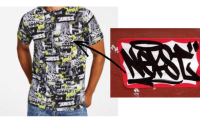MoMA Alters Wall Text for Video Installation After Being Accused of Promoting ‘Garbage Putinist Discourse’
New York’s Museum of Modern Art changed the wall text for a work in a sizable survey of video art after some social media users accused the caption of putting forward a conspiracy theory by Russian President Vladimir Putin.
The work, U.S. Greatest Hits Mixtape Volume 1 (2019), is by Frances Stark and features six screens, each of which display images shot on Stark’s iPhone that comment on US intervention in conflicts abroad. Those images, which display screens playing YouTube clips, are paired with popular music dating to the years of the wars referenced.
Stark has said the work is about “the paradoxes we face, the difficulty of dealing with being complicit, and the discomfort about where power lies.” The piece currently figures in “Signals: How Video Transformed the World,” one of the biggest exhibitions devoted to art made in the medium in decades.
The original wall text stated, “This series examines the history of US military intervention in six countries: Syria (1949), Iran (1953), Afghanistan (1979), Libya (2011), Ukraine (2013), and Venezuela (2019).”
However, there was no known US military intervention in 2013. In late 2013, Ukraine saw large-scale protests that eventually developed into the Maidan Revolution in early 2014. That February, Russia invaded Ukraine and formally annexed the peninsula of Crimea. At the time, Putin tried to position Russia’s annexation as a measure taken to safeguard the region from Western intervention.
“Our Western partners headed by the United States prefer not to be guided by international law in their practical policies, but by the rule of the gun,” Putin said in 2014. “They have come to believe in their exceptionalism and their sense of being the chosen ones. That they can decide the destinies of the world, that it is only them who can be right.”
Ivan Aleksandrov, a PhD student at New York University, flagged the Ukraine portion of Stark’s work on Twitter on March 11, a few days after “Signals” opened. Aleksandrov wrote, “Um, @MuseumModernArt are you doing okay?? What the hell is ‘US military intervention in… Ukraine (2013)’?? Another day of garbage Putinist discourse getting picked up by American contrarians who, in fact, don’t give a damn about communities they claim to be so concerned about.”
At this time of writing, Aleksandrov’s tweet has gained more than 1,800 likes.
Subsequent tweets from other users pointed out that Stark’s footage drew on a video uploaded by Representative Press. That outlet’s YouTube channel features, among other things, a playlist of videos about Russia’s Foreigner Minister, who “says what Western mainstream media is unwilling to say,” per its description, noting that “U.S. news isn’t telling you what you need to know.”
The video seen in Stark’s artwork, titled “Nuland Privately Cooks Up Ukraine Deal, Publicly Claims ‘Ukrainian Democracy’ Concern,” can be seen playing on a desktop monitor while the music video for Katy Perry’s song “Roar” is simultaneously being streamed on another computer placed adjacent to it. Much of the original Representative Projects video is an unedited US State Department press briefing, but it ends with an addition from its uploader about “the maneuvering and manipulations behind the scenes in the service of private greed.” Stark’s work, which can be viewed online, does not contain this last segment.
Since Aleksandrov’s tweet, ARTnews has learned, MoMA has re-edited the work’s wall text. The years associated with each invasion have been stripped out, and additional phrasing has been inserted regarding the work’s origins.
“This series of assemblages displays video content and news clips examining US intervention and alleged or covert involvement in six countries—Syria, Iran, Afghanistan, Libya, Ukraine, and Venezuela,” the wall text now reads.
In a statement to ARTnews, a MoMA spokesperson said, “We always welcome comments about works of art in our collection and several people reached out in the last few weeks about U.S. Greatest Hits Mix Tape Volume I. The curatorial team and artist were already in dialogue about that material and decided changes were needed to the description of the work.”
Stark did not respond to a request for comment sent to Gladstone Gallery, her New York representative.



